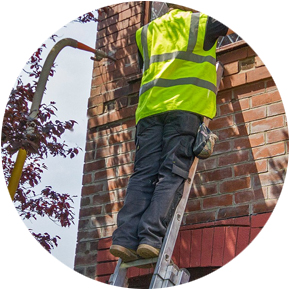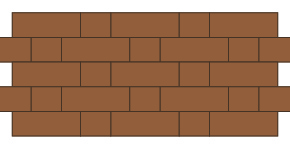Cavity Wall Insulation
100% Grant Funded Cavity Wall Insulation
Cavity Wall Insulation (CWI), is the process of blowing a highly efficient material such as a thermal bead or wool in to the gaps between the two skins of brick around a property. An insulated cavity can save you up to £140 per year and retain heat within your home for longer.
Generally, no. Having cavity wall insulation is not a messy process, holes are drilled in to the pointing on the external (sometimes internal) elevations, a machine seals within these holes and the material is then blown in. The excess is minimal and should be cleared by the engineers.
If your home was built after the 1920s, then there is a good chance that you have a cavity construction. If you have had windows replaced, you would have seen the gap in-between the skins of the building. You can also tell by the 'brick bond', there is more information below.
Generally, most installers will use either a white wool, or bead style product to insulate your walls. Bead is a modern material, with high insulative properties. Wool is a little older and has been used for longer, so you could say it has been tried and tested. There is no great difference between the two.
Cavity Insulation can be free if you live in a certain postcode area (generally of low income) - You can use our checker here. You may also qualify if you receive certain income related benefits - you can check here. You may also qualify if you walls are hard to treat, or your home is three storeys.
In short, yes. You wouldn't go to the shops on a cold day without wearing a coat, would you? If your walls are un-insulated and you qualify to have it done for free then it is highly reccommended and will make a huge difference instantly on your monthly bills. Especially in winter.
Typical Annual Savings |
|---|
Cavity Wall Insulation |
Save Up to £140 Per Year |

Funding for insulation has been split in to three categories, you can qualify for free cavity wall insulation because of the income related benefits which you receive (HHCRO), the style/construction of the property in which you live (CERO) or even your specific postcode area (CSCO).
It is important for private tenure home owners to know that it is not always free to those in receipt of benefits, you may receive no benefits at all and live in a relatively wealthy area, but because your property is three storeys or has a narrow (less than 50mm) cavity wall, then it can still be free. It can also be free if your home requires 4 or more hours worth of remedial work including rubble to be cleared from the cavity, re-pointing etc.

We set up GetGrants to help home owners and private tenants to secure 100% grants for home insulation, and replacement boilers. Our online application can tell you within minutes what you do and do not qualify for, once we have approved your details we will then pass them on to a local, certified and quality checked installer who will arrange to survey your home and move forward with the job.
GetGrants do not install anything, we provide a platform for people nationwide to get access to approved installers who can look after your requirements. We are effectively, a middle-man, but we're free for you to use.
The process is relatively straight forward, once you have completed our online grant application and your details have been approved we will then send your information through to a local, certified installer. They will carry out a technical survey on your home to determine which walls can be insulated and complete a "Green Deal Survey" (not to be confused with a Green Deal Loan!). This survey will demonstrate what savings can be made.
To complete the actual cavity wall insualtion, engineers will drill a pattern of holes in to the elevations of your home (they are done through the pointing), if the engineer is using a 'bead' type product there will be less holes required to drill, if using wool, there will be a small amount more. The holes are then injected, or blown with the insulative material until full. The holes are then re-pointed with a pigmented sand and cement to ensure the match is as close to the original as possible. It is hard to tell it has been done once completed. Cavity Wall Insulation carries a guarantee for 35 years, it is called a CIGA guarantee.



In the UK, most homes constructed after the 1920's are likely to have cavity walls. Properties which were built before this time are more likely to have solid brick walls. If your home is of a non-standard construction it could have been built with concrete, timber frame, steel frame or a few others.
Go outside of your property and take a look at the external elevations, it is possible to work out what type of wall you have from just looking at it. If you have a cavity wall, your bricks will have a regular pattern and look like the image below (courtesy of the Energy Saving Trust):

As you can see above, a standard cavity has a very uniform look to it. There are two skins to the walls, which are held together with 'Ties'. These types of walls can be insulated for free using a grant.

Rather than using 'Ties' like a cavity wall, a Solid Brick holds together by placing the bricks longways over both skins to hold them together. You can insulte these walls internalls or externalls (EWI).
By looking at the elevations of your building, you should have been able to identify what type of wall you have. If you haven't, dont worry, we can arrange for a local surveyor to come and see you free of charge to work out what walls you have and to see how we can help with some free home insulation.
Yes, 100%. If you have a home which was built after around the 1920's then there is a pretty good chance that its walls have been built with "Cavity" construction. This means that your walls have two outer skins with an air gap inbetween, you might have noticed this when you had windows removed or replaced. If your cavity wall is un-insulated, this gap has nothing in it meaning that precious heat which you are paying generate is being lost through the walls. Once your walls are filled with bead, wool, or even foam, then this heat retains within your home for much longer which means you can turn your central heating off sooner or turn the stat down to start saving money instantly.
Cavity walls are not only found in standard brick alone. Cavity walls can be found within timber frames, random stone buildings, dressed stone and some others. Different wall types require different materials to insulate them, for example a random stone building would require a more bespoke material to insulate its cavity, this is due to the fact that the cavity wall will be of different depths throughout, foam is often used to insulate this type of wall because it expands to fill any uneven gaps and holes in its construction. You could not use a standard wool type product with random stone because the wool may not fill all of the small gaps and changes in the cavities depth, the wall needs to be fully filled otherwise you may end up with cold spots. Timber frame or steel frame can not be insulated in the same way as a brick cavity, these walls require a more specialist approach and general utilise Kingspan on the internal elevations.
Many moons ago, Stone walls were only solid and could be up to 20" thick. However in recent times, Random Stone has been used to dress the external elevation of more modern Cavity style constructions. Generally these types of wall can only be insulated with a Foam type product.
You can not insulate a timber or steel frame with a cavity using a standard wool, or bead type product. These generally require a more specialist approach and most companies will use a Kingspan board on the internal elevations. There are currently no grants available for timber/steel frame constructions.
There are a few materials to consider when having your walls insulated, different companies generally use one of three. Bead and wool are the most-common, whilst new materials such as expanding foam are also growing in popularity. Generally, they all do pretty much the same job.
There have been many tests to determine what long term effects filling a cavity can have on a properties construction. We began to use a cavity wall construction because builders needed a way to stop penetrating rain getting in through the walls of your home, the gap inbetween the bricks stopped moisture soaking in to the inside of the property and causing damp. By filling this gap with insulation, people say it gives the moisture a way to bridge across to the internal skin. But, all modern houses that are built with a cavity have insulation in the walls which is determined by building regulations, so does this mean all new homes will suffer from damp? Engineers will check that the cavity in your home is clear before insulating it and you will also get a 25 year CIGA Guarantee.
At GetGrants we have a nationwide network of installers who all have different skill-sets, each company can offer different services which means that we can offer pretty much anything if there is a grant currently available. Currently, we are giving private tenants, landlords and home owners the chance to access grants for:- Cavity Wall insulation including those with 'Random Stone' & 'Dressed Stone' construction, loft insulation to get your property up to current regulations at 270mm and external wall insulation which is used on hard to treat properties such as solid brick construction.
Currently, Solar Panels are not fully funded under the ECO. There was a huge increase in the popularity of Solar up until recently when the Feed-In-Tarrif (FIT) was scrapped. The feed in meant that many companies would install Solar Panels on to your roof completely free of charge with no costs involved what so ever, there would be a contract in place which meant that the installer of the panels would get an income from the 'FIT' and the home owner would benefit from having lower monthly bills, it was a win-win. Unfortuantley, the Feed in Tarrif got scrapped and the vast majority of the Solar companies pulled out of doing such deals.
We do not offer any grants to home owners or private tenants for free Solar installations, but the criteria is always changing so be sure to check back on this website or sign up for our newsletter to keep yourselves informed of the latest home efficiency grants and offers available.
Applying for a Cavity Wall Insulation grant is easy, enter your postcode on the right and go through our quick online application. We will tell you what you do and don't qualify for, and have one of our installers get in touch.
Simply enter your postcode below and then some brief details about your current position to see what grants you qualify for:
Find out now